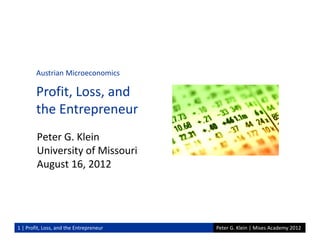Austrian Microeconomics, Lecture 5 with Peter Klein - Mises Academy
- 2. 2 |¬†Profit,¬†Loss,¬†and¬†the¬†Entrepreneur Peter¬†G.¬†Klein¬†|¬†Mises¬†Academy¬†2012 The¬†evenly¬†rotating¬†economy ‚Ėļ Recap:¬†imaginary¬†constructs¬†in¬†causal‚Äźrealist¬†analysis ‚Ėļ The¬†imaginary¬†construction¬†of¬†the¬†evenly¬†rotating¬†economy¬† (ERE) Ôāß Passage¬†of¬†time Ôāß ‚ÄúAction‚Äźlike‚Ä̬†behavior Ôāß No¬†uncertainty ‚Ėļ Purpose¬†of¬†the¬†ERE Ôāß Distinguishing¬†profit¬†from¬†interest Ôāß Isolating¬†the¬†function¬†of¬†entrepreneurship
- 3. 3 |¬†Profit,¬†Loss,¬†and¬†the¬†Entrepreneur Peter¬†G.¬†Klein¬†|¬†Mises¬†Academy¬†2012 The¬†entrepreneurial¬†function ‚Ėļ Entrepreneurship:¬†deployment¬†of¬†resources¬†(in¬†the¬†present)¬†in¬† anticipation¬†of¬†(uncertain)¬†future¬†receipts. Ôāß Implies¬†property¬†ownership Ôāß May¬†or¬†may¬†not¬†imply¬†imagination,¬†creativity,¬†alertness,¬†leadership,¬†etc. ‚Ėļ Profit¬†(loss):¬†residual¬†accruing¬†to¬†business¬†owner¬†after¬†factors¬†of¬† production¬†have¬†been¬†paid. Ôāß In¬†the¬†ERE,¬†all¬†factor¬†prices¬†would¬†equal¬†their¬†DMRPs¬†ÔɆ no¬†profit¬†or¬†loss ‚Ėļ Laborers:¬†earn¬†wages ‚Ėļ Landowners:¬†earn¬†rents ‚Ėļ Capitalists:¬†earn¬†interest Ôāß Profit¬†and¬†loss¬†can¬†thus¬†only¬†exist¬†under¬†conditions¬†of¬†uncertainty. Ôāß Note¬†on¬†profit¬†measurement,¬†profit¬†rates,¬†etc.
- 4. 4 |¬†Profit,¬†Loss,¬†and¬†the¬†Entrepreneur Peter¬†G.¬†Klein¬†|¬†Mises¬†Academy¬†2012 Uncertainty¬†versus¬†risk ‚Ėļ Frank¬†Knight¬†(1921)¬†on¬†risk¬†and¬†uncertainty Ôāß Risk: possible¬†outcomes¬†and¬†probabilities¬†are¬†known Ôāß Uncertainty:¬†probability¬†distribution¬†is¬†unknown ‚Ėļ Richard¬†(and¬†Ludwig)¬†von¬†Mises¬†on¬†probability Ôāß Class¬†probability:¬†event¬†is¬†part¬†of¬†a¬†class¬†of¬† similar,¬†repeatable¬†events ‚Ėļ Games¬†of¬†chance ‚Ėļ Insurance Ôāß Case¬†probability:¬†event¬† constitutes¬†a¬†unique¬†case ‚Ėļ Understanding
- 5. 5 |¬†Profit,¬†Loss,¬†and¬†the¬†Entrepreneur Peter¬†G.¬†Klein¬†|¬†Mises¬†Academy¬†2012 What¬†profit¬†is¬†not ‚Ėļ Interest Ôāß Interest:¬†reward¬†for¬†foregoing¬†consumption Ôāß Profit:¬†reward¬†for¬†successfully¬†bearing¬†uncertainty ‚Ėļ Accounting¬†income Ôāß Accounting¬†income¬†includes¬†profit,¬†interest,¬†and¬†the¬†entrepreneur‚Äôs¬† implicit¬†wage Ôāß Economic¬†concept¬†of¬†profit¬†as¬†a¬†functional¬†category,¬†not¬†a¬†line¬†item¬†on¬† the¬†income¬†statement ‚Ėļ An¬†automatic¬†‚Äúreturn¬†to¬†capital‚ÄĚ ‚Ėļ A¬†markup¬†over¬†production¬†costs
- 6. 6 |¬†Profit,¬†Loss,¬†and¬†the¬†Entrepreneur Peter¬†G.¬†Klein¬†|¬†Mises¬†Academy¬†2012 Entrepreneurship¬†and¬†resource¬†heterogeneity ‚Ėļ Austrian¬†capital¬†theory:¬†heterogeneous,¬†subjectively¬†perceived¬† resources ‚Ėļ Lachmann (1956)¬†on¬†heterogeneity:¬†‚ÄúWe¬†are¬†living¬† in¬†a¬†world¬†of¬†unexpected¬†change;¬†hence¬†capital¬† combinations¬†.¬†.¬†.¬†will¬†be¬†ever¬†changing,¬†will¬†be¬† dissolved¬†and¬†reformed.¬†In¬†this¬†activity,¬†we¬†find¬†the¬† real¬†function¬†of¬†the¬†entrepreneur.‚ÄĚ ‚Ėļ Note:¬†given¬†resource¬†heterogeneity,¬†profits¬†and¬† losses¬†can¬†only¬†be¬†calculated¬†in¬†a¬†money¬†terms. Ludwig¬†Lachmann
- 7. 7 |¬†Profit,¬†Loss,¬†and¬†the¬†Entrepreneur Peter¬†G.¬†Klein¬†|¬†Mises¬†Academy¬†2012 The¬†capitalist¬†and¬†the¬†entrepreneur ‚Ėļ The¬†business¬†firm:¬†intersection¬†of¬†the¬† capitalist¬†and¬†entrepreneur¬†functions ‚Ėļ Insights¬†from¬†Austrian¬†economics Ôāß Capital¬†resources¬†are¬†heterogeneous Ôāß Production¬†takes¬†time Ôāß Entrepreneurs¬†perform¬†economic¬† calculation Ôāß Market¬†competition¬†selects¬†for¬† entrepreneurial¬†skill
- 8. 8 |¬†Profit,¬†Loss,¬†and¬†the¬†Entrepreneur Peter¬†G.¬†Klein¬†|¬†Mises¬†Academy¬†2012 Social¬†functions¬†of¬†profits¬†and¬†losses ‚Ėļ Provides¬†feedback¬†to¬†entrepreneurs¬†in¬† short‚Äź and¬†long‚Äźrun¬†planning Establishes¬†a¬†selection¬†process¬†for¬† entrepreneurship,¬†placing¬†productive¬† resources¬†under¬†the¬†custody¬†of¬†those¬† who¬†can¬†best¬†use¬†them¬†to¬†satisfy¬† consumer¬†wants. ‚Ėļ Note:¬†no¬†such¬†thing¬†as¬†‚Äúnormal¬†profits,‚Ä̬†‚Äúexcessive¬†profits,‚Ä̬†etc.
- 9. 9 |¬†Profit,¬†Loss,¬†and¬†the¬†Entrepreneur Peter¬†G.¬†Klein¬†|¬†Mises¬†Academy¬†2012 Mises‚Äôs¬†entrepreneur‚Äźpromoter ‚Ėļ A¬†special¬†class¬†of¬†entrepreneur Ôāß Economics¬†‚Äúalso¬†calls¬†entrepreneurs those¬†who¬†are¬†especially¬†eager¬†to¬† profit¬†from¬†adjusting¬†production¬†to¬†the¬†expected¬†changes¬†in¬†conditions,¬† those¬†who¬†have¬†more¬†initiative,¬†more¬†venturesomeness,¬†and¬†a¬†quicker¬† eye¬†than¬†the¬†crowd,¬†the¬†pushing¬†and¬†promoting¬†pioneers¬†of¬†economic¬† improvement‚Ä̬†(Mises,¬†1949,¬†p.¬†255). Ôāß Mises‚Äôs¬†suggested¬†term¬†for¬†these:¬†promoter ‚Ėļ Characteristics¬†of¬†the¬†promoter Ôāß Owns¬†and¬†invests¬†financial¬†and/or¬†physical¬†capital Ôāß Is¬†particularly¬†alert¬†to¬†profit¬†opportunities Ôāß Exhibits¬†creativity¬†and¬†leadership Ôāß A¬†more¬†loosely¬†defined,¬†historically¬†contingent¬† concept¬†than¬†the¬†pure,¬†functional¬†entrepreneur
- 10. 10 |¬†Profit,¬†Loss,¬†and¬†the¬†Entrepreneur Peter¬†G.¬†Klein¬†|¬†Mises¬†Academy¬†2012 Entrepreneurs¬†and¬†managers ‚Ėļ Original¬†and¬†derived¬†judgment Ôāß Original¬†judgment¬†‚Äď can¬†only¬†be¬†exercised¬†by¬†resource¬†owners. Ôāß Derived¬†judgment¬†‚Äď exercised¬†by¬†subordinates¬†who¬†are¬†delegated¬† specified¬†decision¬†rights,¬†acting¬†as¬†‚Äúproxy¬†entrepreneurs.‚ÄĚ ‚Ėļ Economics¬†of¬†organization:¬†art¬†of¬†managing¬†derived¬†judgment
- 11. 11 |¬†Profit,¬†Loss,¬†and¬†the¬†Entrepreneur Peter¬†G.¬†Klein¬†|¬†Mises¬†Academy¬†2012 Alternative¬†perspectives¬†on¬†the¬†entrepreneurial¬†function ‚Ėļ Israel¬†Kirzner:¬†entrepreneurship¬†as¬†alertness¬†to¬† opportunities Ôāß Similar¬†to¬†Mises‚Äôs¬†promoter,¬†but¬†without¬†capital Ôāß Entrepreneurship¬†(necessarily?)¬†‚Äúpierces¬†the¬†fog‚ÄĚ of¬†uncertainty‚ÄĚ Ôāß Focuses¬†not¬†on¬†profit¬†and¬†loss,¬†but¬†on¬†equilibration ‚Ėļ Joseph¬†Schumpeter: entrepreneurship¬†as¬†the¬†introduction¬† of¬†new¬†products,¬†processes,¬†markets Ôāß An¬†‚ÄúAustrian‚Ä̬†addition¬†to¬†Walrasian general¬†equilibrium Ôāß Sees¬†the¬†entrepreneur¬†as¬†a¬†disequilibrating force¬† (‚Äúcreative¬†destruction‚ÄĚ) ‚Ėļ Mises:¬†closer¬†to¬†Knight‚Äôs¬†view¬†of¬† entrepreneurship¬†as¬†judgmental¬†decision‚Äź making¬†under¬†uncertainty
- 12. 12 |¬†Profit,¬†Loss,¬†and¬†the¬†Entrepreneur Peter¬†G.¬†Klein¬†|¬†Mises¬†Academy¬†2012 Alternative¬†concepts¬†of¬†entrepreneurship ‚Ėļ Occupational¬†concepts Ôāß Entrepreneur¬†=¬†self‚Äźemployed¬†individual Ôāß Labor¬†economics¬†literature¬†on¬†occupational¬†choice Ôāß Psychological¬†studies¬†of¬†the¬†entrepreneur‚Äôs¬†characteristics ‚Ėļ Structural¬†concepts Ôāß Unit¬†of¬†analysis:¬†the¬†firm¬†or¬†industry Ôāß Entrepreneurial¬†firm¬†=¬†new¬†or¬†small¬†firm Ôāß IO¬†literature¬†on¬†industry¬†evolution¬† ‚Ėļ Note:¬†little¬†relationship¬†to¬†functional¬†approaches
- 13. 13 |¬†Profit,¬†Loss,¬†and¬†the¬†Entrepreneur Peter¬†G.¬†Klein¬†|¬†Mises¬†Academy¬†2012 Implications¬†for¬†the¬†theory¬†of¬†the¬†firm ‚Ėļ Neoclassical¬†view:¬†firm¬†as¬†production¬†function ‚Ėļ Austrian¬†view:¬†firm¬†as¬†ownership¬†of¬†assets Ôāß The¬†firm¬†is¬†the¬†capitalist‚Äźentrepreneur¬†(or¬†a¬†group¬†of¬†capitalist‚Äź entrepreneurs)¬†plus¬†the¬†alienable¬†assets¬†he¬†owns. Ôāß Ownership¬†conveys¬†authority¬† Ôāß Firms¬†can¬†own¬†many,¬†or¬†no,¬†production¬†processes¬†(functions).
- 14. 14 |¬†Profit,¬†Loss,¬†and¬†the¬†Entrepreneur Peter¬†G.¬†Klein¬†|¬†Mises¬†Academy¬†2012 The¬†theory¬†of¬†the¬†firm ‚Ėļ Why¬†do¬†firms¬†exist? Ôāß Transaction¬†costs¬†of¬†market¬†exchange¬†(Coase¬†1937) Ôāß Entrepreneurial¬†judgment¬†is¬†non‚Äźcontractible¬†(Knight,¬†1921) ‚Ėļ What¬†determines¬†the¬†boundary¬†of¬†the¬†firm? Ôāß Internal¬†and¬†external¬†transaction¬†costs¬† Ôāß Entrepreneurial¬†talent Ôāß Need¬†for¬†economic¬†calculation¬†(Rothbard) ‚Ėļ How¬†should¬†the¬†firm¬†be¬†organized? Ôāß Costs¬†and¬†benefits¬†of¬†delegation¬†(Foss,¬†Foss,¬†and¬†Klein,¬†2007)
- 15. 15 |¬†Profit,¬†Loss,¬†and¬†the¬†Entrepreneur Peter¬†G.¬†Klein¬†|¬†Mises¬†Academy¬†2012 The¬†limits¬†to¬†the¬†firm ‚Ėļ Incremental¬†limits:¬†indivisibility¬†in¬†the¬†entrepreneurial¬†judgment ‚Ėļ Ultimate¬†limit:¬†need¬†for¬†external¬†markets¬†for¬†all¬†internally¬† transferred¬†factors Ôāß The¬†vertical¬†stages¬†of¬†production Ôāß Divisional¬†profit¬†and¬†loss Ôāß Need¬†for¬†market‚Äźbased¬†transfer¬†prices¬† ‚Ėļ Calculational chaos Ôāß As¬†external¬†markets¬†disappear,¬†‚Äúislands¬†of¬†noncalculable chaos¬†swell¬†to¬† the¬†proportions¬†of¬†masses¬†and¬†continents.¬†As¬†the¬†area¬†of¬†incalculability¬† increases,¬†the¬†degrees¬†of¬†irrationality,¬†misallocation,¬†loss,¬† impoverishment,¬†etc.,¬†become¬†greater‚Ä̬†(p.¬†548). ‚Ėļ Relationship¬†to¬†socialist¬†calculation¬†debate















